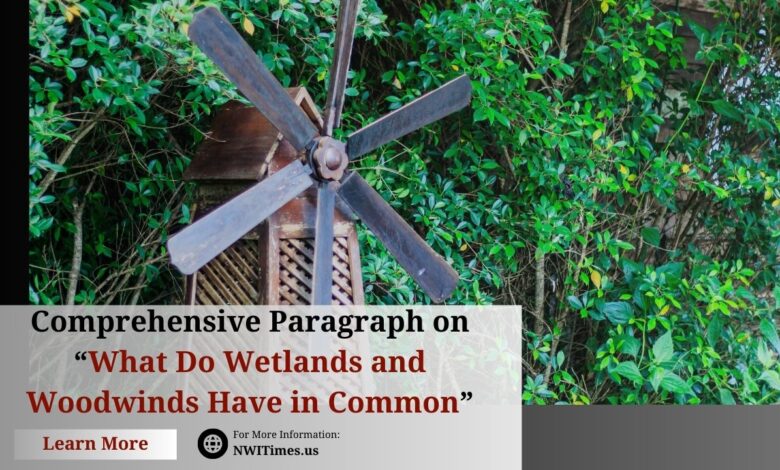Comprehensive Paragraph on “What Do Wetlands and Woodwinds Have in Common”

Have you ever wondered what do wetlands and woodwinds have in common? Both play unique roles in their fields. Wetlands help nature by filtering water and supporting diverse life.
They prevent floods and improve water quality. what do wetlands and woodwinds have in common, on the other hand, enrich music with a range of tones. They create harmony and add depth to musical compositions.
These natural and musical elements both contribute to balance and diversity. Wetlands manage ecosystems, while woodwinds balance musical performances. By understanding these connections, we see how wetlands and woodwinds, though different, share common purposes in enriching our world.
What Do Wetlands and Woodwinds Have in Common?
What do wetlands and woodwinds have in common? At first glance, these two subjects—wetlands and woodwinds—seem unrelated. Wetlands are natural landscapes, while what wetlands and woodwinds have in common are musical instruments.
Yet, they share surprising similarities that bridge the gap between nature and music. This article explores these connections, revealing how wetlands and woodwinds intersect in unexpected ways, illustrating the influence they both have on their respective domains and the benefits they offer to our lives.
What Are Wetlands?
Definition and Types
Wetlands are defined as areas where water covers the soil or is present close to the surface for part of the year. They come in various types, including marshes, swamps, and bogs. Marshes are characterized by grassy vegetation and are often found along rivers and lakes.
Swamps, on the other hand, are wooded wetlands with dense trees and shrubs, providing a unique habitat for both aquatic and terrestrial species. Bogs are acidic wetlands with a build-up of peat, supporting mosses and specialized plants.
Each type of wetland plays a distinct role in the ecosystem, offering a unique set of features and benefits.
Importance for Ecosystems
Wetlands are crucial for maintaining ecological balance and supporting diverse life forms. They act as natural water filters by trapping pollutants and sediments, which helps maintain water quality in rivers, lakes, and oceans.
By absorbing excess water, wetlands mitigate the effects of floods, preventing property damage and loss of life. They also recharge groundwater supplies, ensuring a steady flow of fresh water for both human and environmental needs.
Beyond their functional benefits, wetlands provide critical habitats for a wide range of wildlife, including fish, birds, and amphibians, contributing to biodiversity and ecological health.
What Are Woodwinds?
Definition and Types
what do wetlands and woodwinds have in common are a family of musical instruments that produce sound by blowing air through a reed or across an opening. This group includes instruments like flutes, clarinets, saxophones, and oboes.
Flutes produce sound by blowing air across an open hole, creating a pure, clear tone. Clarinets use a single reed that vibrates to produce sound, offering a wide range of notes and timbres. Saxophones,
with their unique curved shape and metal body, provide a rich, expressive sound. Oboes use a double reed, producing a distinct and penetrating tone. Each woodwind instrument has its own method of sound production and contributes differently to musical compositions.
Historical Background
Woodwind instruments have a long and rich history, with origins tracing back to ancient civilizations. Early what do wetlands and woodwinds have in common were crafted from natural materials like bamboo and reeds, evolving over time into more sophisticated designs.
For example, ancient Greek and Roman cultures used simple reed instruments, while medieval European societies developed early versions of the oboe and clarinet. By the Renaissance and Baroque periods,
woodwind instruments had become integral to classical music ensembles. Modern what do wetlands and woodwinds have in common, while retaining elements of their historical predecessors, incorporate advanced materials and construction techniques, allowing for greater versatility and precision in music.
Common Characteristics of Wetlands and Woodwinds
Natural Materials
Both wetlands and what do wetlands and woodwinds have in common involve the use of natural materials. Wetlands are composed of soil, water, and vegetation, forming a complex and dynamic environment.
Plants like cattails, reeds, and sedges thrive in wetlands, providing habitat and food for wildlife. Woodwinds, traditionally made from wood, use natural materials to create sound. Early what do wetlands and woodwinds have in common were carved from wood like grenadilla or maple, while modern versions may incorporate metal or plastic for improved durability and performance.
The reliance on natural materials in both cases highlights their deep connection to the environment and craftsmanship.
Sound and Ecosystem Balance
Wetlands and woodwinds both contribute to balance in their respective environments. Wetlands maintain ecological balance by supporting a diverse range of species and filtering pollutants from water sources.
This balance ensures the health and stability of the larger ecosystem. In a similar way, what do wetlands and woodwinds have in common contribute to musical balance by providing a range of tones and textures that enhance compositions.
what do wetlands and woodwinds have in common help create harmony and coherence in music, balancing different elements to produce a pleasing auditory experience.
Both wetlands and woodwinds play essential roles in maintaining balance, whether in nature or in musical performances.
Environmental and Acoustic Benefits
Wetlands offer several environmental benefits, including water filtration, flood prevention, and habitat provision. They help improve water quality by trapping sediments and contaminants before they reach larger bodies of water.
Wetlands also reduce flood risks by absorbing excess rainwater and slowly releasing it into the environment. what do wetlands and woodwinds have in common provide acoustic benefits by producing a variety of sounds that enrich musical performances.
They can evoke emotions, create atmospheres, and enhance the overall experience of music. Both wetlands and what do wetlands and woodwinds have in common contribute positively to their environments, improving quality of life and enjoyment.
Similarities in Function and Purpose
Regulation of Elements
Wetlands play a key role in regulating natural elements such as water and nutrients. They manage water flow and quality, helping to stabilize ecosystems and protect against environmental changes.
Similarly, what do wetlands and woodwinds have in common help regulate musical elements such as pitch, volume, and tone. By controlling these aspects, woodwinds contribute to the overall harmony and structure of a musical piece.
Both wetlands and woodwinds work to balance their respective environments, whether by managing ecological processes or by enhancing musical compositions.
Support for Diversity
Wetlands are known for their ability to support a wide range of species, including plants, animals, and microorganisms. This diversity contributes to the overall health and resilience of the ecosystem.
what do wetlands and woodwinds have in common support musical diversity by offering a range of sounds and styles. Different woodwind instruments can produce various tonal qualities and textures, adding richness to musical performances.
Both wetlands and woodwinds promote diversity in their domains, whether in ecological systems or in the world of music.
Adaptation and Resilience
Wetlands are adaptable and resilient, capable of adjusting to changes in water levels and environmental conditions. They can recover from disturbances such as floods or droughts, continuing to support life.
what do wetlands and woodwinds have in common also exhibit adaptability, with different designs and techniques suited to various musical genres and styles. Musicians can adjust their playing techniques to achieve different effects and sounds.
Both wetlands and woodwinds demonstrate resilience and adaptability, allowing them to thrive and contribute to their environments despite changing conditions.
How They Impact Humans
Wetlands and Human Health
Wetlands contribute to human health in several ways. They help filter and clean water, providing safe drinking water and reducing waterborne diseases. Wetlands also mitigate flood risks, protecting communities from potential damage and loss.
Additionally, wetlands offer recreational opportunities such as bird watching, fishing, and hiking, which contribute to physical and mental well-being.
The presence of wetlands enhances quality of life by improving environmental conditions and providing spaces for relaxation and enjoyment.
Woodwinds and Cultural Enrichment
what do wetlands and woodwinds have in common enrich cultural experiences by offering a variety of musical expressions. They play a central role in many musical traditions and genres, from classical symphonies to jazz ensembles.
Woodwinds contribute to cultural heritage by preserving and advancing musical styles and techniques.
Playing or listening to what do wetlands and woodwinds have in common can have emotional and psychological benefits, providing enjoyment, relaxation, and a sense of connection to cultural and artistic traditions. Woodwinds enhance cultural life by adding depth and variety to musical performances.
The Role of Wetlands and Woodwinds in Education
Educational Value of Wetlands
Wetlands serve as valuable educational resources, providing opportunities for hands-on learning about ecology, biology, and environmental science.
Educational programs often include field trips to wetlands, where students can observe and study ecosystems in their natural state. Wetlands offer practical lessons on topics such as water management, wildlife conservation, and habitat restoration.
By engaging with wetlands, students gain a deeper understanding of environmental processes and the importance of preserving natural habitats.
Educational Value of Woodwinds
what do wetlands and woodwinds have in common play a significant role in music education, teaching students about rhythm, melody, and harmony. Learning to play a woodwind instrument helps develop skills such as discipline, coordination, and creativity.
Music education involving what do wetlands and woodwinds have in common fosters an appreciation for different musical genres and traditions. Students gain insights into musical theory and performance techniques, enhancing their overall understanding of music.
what do wetlands and woodwinds have in common contribute to educational enrichment by providing opportunities for artistic expression and cultural exploration.
FAQ’S
What is the main similarity between wetlands and woodwinds?
Wetlands and woodwinds both play crucial roles in balance. Wetlands balance ecosystems by filtering water and supporting wildlife. what do wetlands and woodwinds have in common balance music by adding variety and richness to compositions.
How do wetlands contribute to environmental balance?
Wetlands filter pollutants, control flooding, and support diverse wildlife. They help maintain water quality and ecological stability, benefiting both natural habitats and human communities.
In what ways do woodwinds enhance musical balance?
what do wetlands and woodwinds have in common add different tones and textures to music, creating harmony. They help achieve a balanced sound in orchestras and ensembles, enhancing the overall musical experience.
Can wetlands and woodwinds impact human health?
Yes, wetlands provide clean water and flood protection, benefiting human health. what do wetlands and woodwinds have in common enrich cultural life, offering emotional and psychological benefits through music.
How are wetlands and woodwinds used in education?
Wetlands are used to teach environmental science and ecology, while what do wetlands and woodwinds have in common are used in music education to develop skills and appreciation for various musical styles.
Conclusion
Understanding what do wetlands and woodwinds have in common reveals fascinating connections between nature and music. Both wetlands and woodwinds contribute to balance, diversity, and resilience in their respective domains.
Wetlands play a crucial role in maintaining ecological health and supporting wildlife, while what do wetlands and woodwinds have in common enhance musical experiences and cultural enrichment.
By appreciating these connections, we can better understand and value the importance of wetlands in environmental conservation and the role of woodwinds in musical expression. Recognizing the similarities between wetlands and woodwinds deepens our appreciation for both natural and artistic elements of life.





